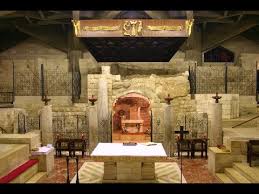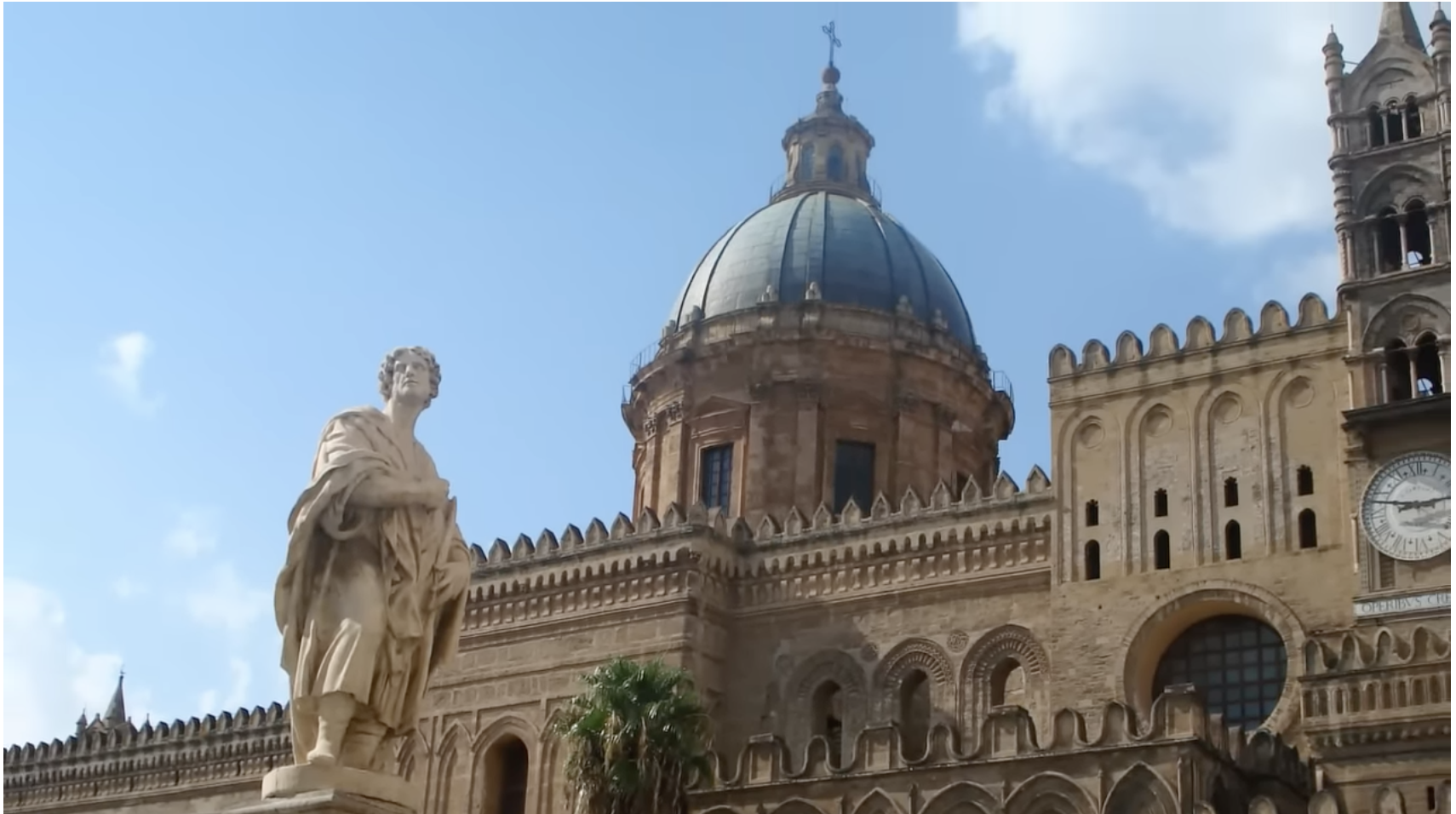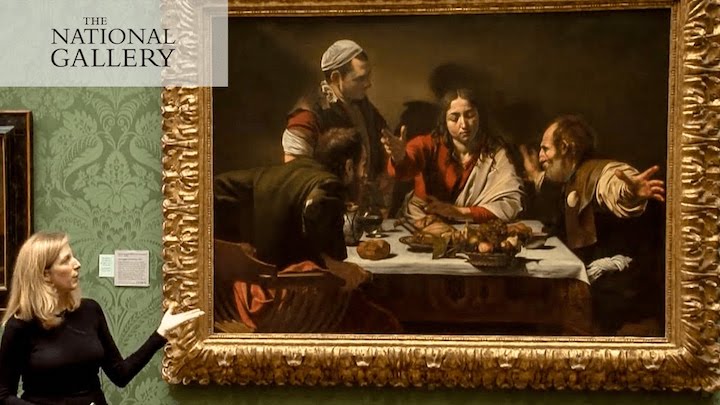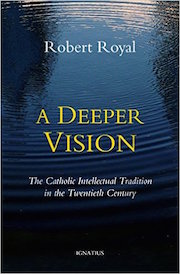Michelangelo Merisi da Caravaggio (1571-1610) created fewer than 100 paintings (that we know of), of which 65 have religious/Biblical themes. His Catholic paintings began with Saint Francis of Assisi in Ecstasy (1595, when he was 24) and culminated with six painted in the year of his death at 38, the last being The Martyrdom of Saint Ursula.
Some skepticism is justified in assigning academic categories to artists in their time. Certainly, Caravaggio never thought of himself as a Late-Renaissance or Mannerist or Early-Baroque painter. He was a young man in a hurry and probably never worried about his place in the pantheon of artists. And, although the case may certainly be made that Leonardo da Vinci (d. 1519) was the greatest figure of the Renaissance (not just an artist but an inventor too) or that Michelangelo Buonarroti (d. 1564) was the greatest artist of the period (a master of sculpture, painting, and architecture), it is Caravaggio who was the greatest painter – and not just of his own period but of all time. That’s my opinion anyhow.
Caravaggio was orphaned at an early age and spent his teenage years as an artist’s apprentice in Milan (Caravaggio is the name of the town of his birth), before moving south to Rome, which is where most of his finest work was done. Rome was a place of power and patronage, and, besides, he was fleeing the Milanese police, one of whom he’d wounded in a brawl. Caravaggio was famous for carrying a sword around town, which was illegal at the time.
It is not uncommon for artists to paint a particular subject more than once. Caravaggio, for instance, did four versions of his earliest known painting, Boy Peeling Fruit (1592-93), and he did two versions of what I think was his greatest subject, Supper at Emmaus – one in 1602 (now in London’s National Gallery) and the other in 1606 (at Pinacoteca di Brera in Milan). The earlier painting shows the young artist at the peak of his powers and confidence, and the later one, though painted just a few years later, suggests a man whose dark vision was growing darker – who had fled south to Naples (an actual murder conviction hanging over him this time) – who could not afford the time and lacked the concentration to properly finish what he started. It seems clear, too, that his spirit was dying.
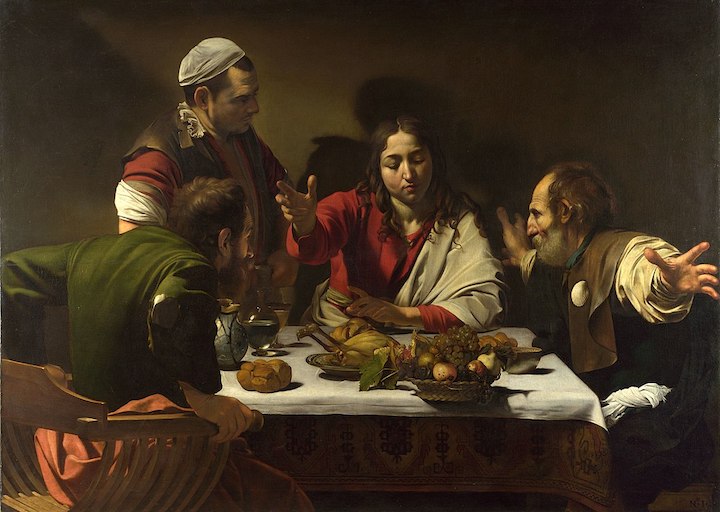
Caravaggio’s work is almost always defined by darkness – by techniques known either as chiaroscuro or tenebrism, both often (the latter especially) credited to him as inventor. In each, darkness is used to give other images in the work an almost three-dimensional effect. In the two Emmaus paintings, the earlier is more chiaroscuro-like; the latter more tenebrist.
Let’s recall the Emmaus story as told in Luke 24:13–35: It’s Easter and two disciples are heading to Emmaus from Jerusalem. A stranger joins them. It’s the risen Lord, but they “were kept from recognizing him.” The stranger relates for them the history of Biblical prophecy – how it all leads to Christ. When they sit down to dine, the stranger breaks the bread, hands it to them, and “their eyes were opened, and they recognized him . . .”
This is the moment Caravaggio has captured – most dramatically, I think, in the colorful London version above. Cleopas, whose face we see more clearly here, is the older of the two and wearing a pilgrim’s clamshell. He is reaching out to embrace the Lord. And why not? According to tradition, he was Christ’s uncle, the brother of Joseph. The other disciple, wearing a green tunic tattered at the elbow, is St. Luke himself, beginning to push back his chair and leap to his feet. When he does, that fruit basket will go flying.
The fourth man looks on in interest. He’s the tavern keeper – thumbs tucked businesslike in his apron. He’s not in on the revelation but is about to be.
Perhaps St. Cleopas was the one who introduced Luke to Our Lady. She was the source of the infancy narrative only Luke relates. Further evidence that this is Luke is his tunic of green, the color often associated with him in art: in early iconography; in a portrait made by Caravaggio’s older contemporary, El Greco (c. 1600); and right up to J.J. Tissot’s watercolor portrait from the 1880s.
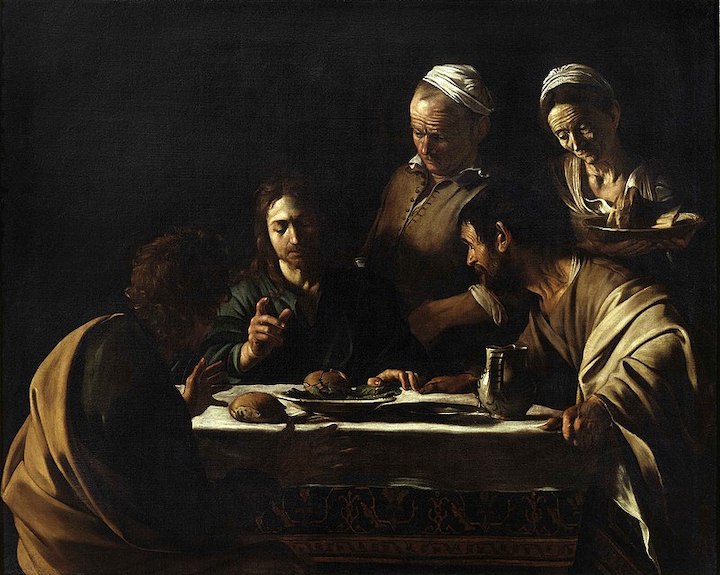
The Supper at Emmaus was an attractive subject for decorating Catholic churches in the 1600s: both because the story celebrates the first post-Resurrection Mass and because it strikes a blow at Protestant iconoclasm. Caravaggio, born less than a decade after the Council of Trent, surely embraced the Council’s belief that art could and should convey theology.
Of course, Council fathers (and popes) often disdained inappropriate art: nudity or portrayals of figures, Christ especially, lacking in solemnity. Because of their revolutionary realism (or “radical naturalism,” which included using street people as models), several of Caravaggio’s paintings were rejected by their clerical patrons. And, in the generation before Caravaggio, Michelangelo’s Sistine Chapel paintings had been controversial because of nudity and because Jesus is beardless – which may well be why Caravaggio himself opted for a beardless Christ in the London Emmaus, which anyway was never meant for a church but the private gallery of a wealthy patron. Its drama, size, and horizontal orientation make that obvious.
TCT is engaged, to an extent, in the ongoing Catholic Counter-Reformation, especially in our celebration of beauty: in music (see True Beauty), architecture (see Sacred Spaces), and art (see every column every day). And whereas we might choose St. John Henry Newman as patron of our literary endeavors, we cannot look to Caravaggio as patron of our artistic efforts. For that, better to choose Bl. Fra Angelico.
There are nine Caravaggios in the U.S.: four in New York (all at the MET) and one each in Cleveland, Detroit, Hartford, Kansas City, and Fort Worth. When museums reopen, seek them out if you can, because genius deserves attention.
NOTE: The painting in situ in London:



